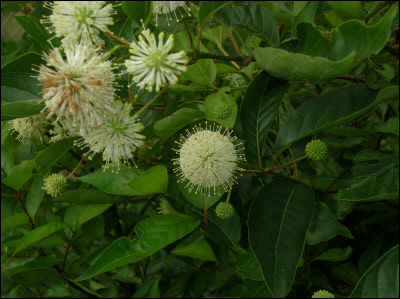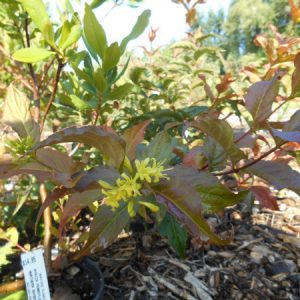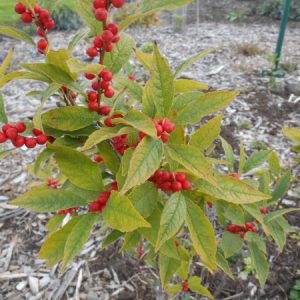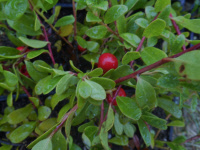White flowers in May turning to dense clusters of lurid red berries lasting from fall into winter on female plants. One male needed to fertilize 3 or 4 4 female plants. Female plants have a plump round ovary at the center and vestigial stamens – sticks up; male flowers have a greatly reduced and lower center-and prominent stamens with ample pollen.
Size: 6-16’ x 6-10’
Care: sun to part shade in moist to moist well-drained, acidic soil
Native: Canada to FL, West to WI and MO. Wisconsin native
Wildlife Value: Berries are important winter food for Robin, Bluejay, Catbird, Cedar waxwing, Chickadee, Finch, Flicker, Mockingbird, Mourning dove, Nuthatch, Sparrow, Tanager, Thrasher, Towhee, Warbler, Woodpecker.
Natives Americans used bark to induce vomiting, to remedy craziness and a decoction of roots to cure hay fever. Ojibwa used roots as remedy for diarrhea. Collected before 1753 by John Bartram (1699-1776) who called it “Prinos.” Jefferson described the Winterberry in Virginia, “the swamps in this neighborhood are now red with this berry… (it is) peculiar to America and is a real treasure.” Grown at America’s 1st botanic garden, Elgin Botanic Garden 1811. L H Bailey (1933) called it, “one of the best hardy shrubs with ornamental fruits.”
Require a male and female plant for cross pollination. This is the female plant that will produce the berries. Generally, only 1 male shrub should be needed to pollinate 3-4 female shrubs.
**LISTED AS OUT OF STOCK BECAUSE WE DO NOT SHIP THIS ITEM. IT IS AVAILABLE FOR PURCHASE AT OUR RETAIL LOCATION.





